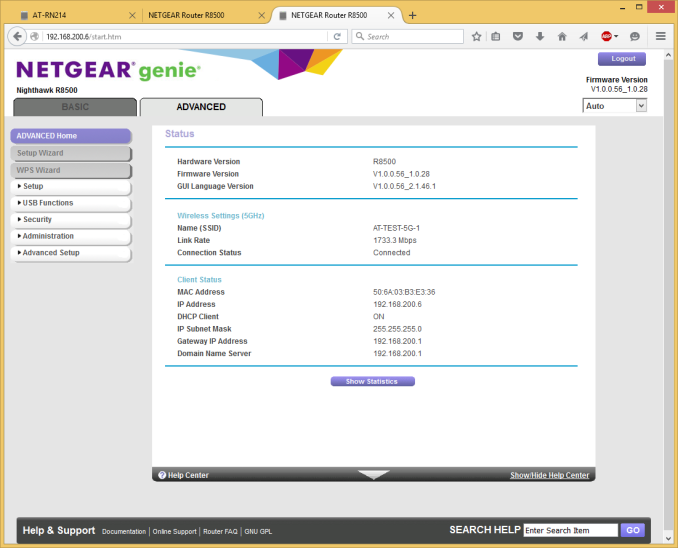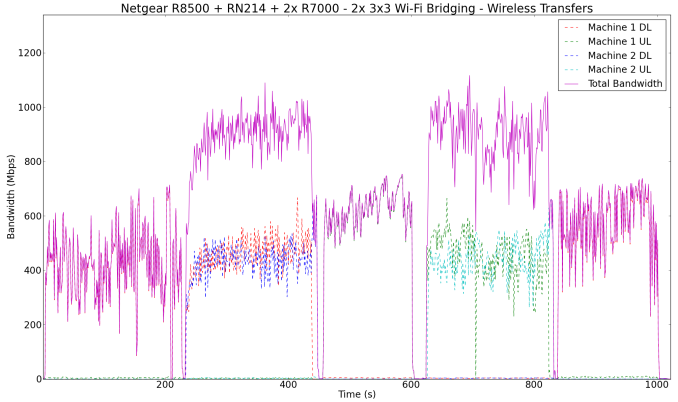Netgear Nighthawk X8 R8500 AC5300 Router Brings Link Aggregation Mainstream
by Ganesh T S on December 31, 2015 8:00 AM EST- Posted in
- Networking
- NetGear
- Broadcom
- 802.11ac
- router
The Promise of Gigabit Wi-Fi
The Nighthawk X8 R8500 is marketed as an AC5300-class router. This naturally leads consumers to wonder whether it is really possible to get gigabit Wi-Fi (considering that an AC5300 router should theoretically support up to 2165 Mbps on each of the 5 GHz bands). In order to test out this aspect, we configured another R8500 in bridge mode (this is necessary to test 4x4 Wi-Fi bridging at the maximum possible link rate because 1024-QAM works only with other Broadcom devices, and the R8500 is the only Broadcom device that also has 4x4 capabilities).
Irrespective of where we placed the bridging router relative to the main R8500, we found that the link rate never reached 2165 Mbps, but topped out at 1733 Mbps. Eventually, we settled down on keeping the bridging router around 10 ft away, but, across a drywall (in order to simulate realistic conditions). The wired PCs connected to ports 3,4 and 5 of the main router were shifted to ports 1,2 and 3 of the bridging R8500. To our consternation, the results from running our folder download / upload test were downright abysmal.
While we did see occasional bursts of more than 800 Mbps during the testing, the majority of the time was spent in the 100 Mbps range. Apparently, we were not the only people to notice this issue, leading me to believe that there is still plenty of scope for performance improvements in the R8500.
It must be noted that the bridged R8500 connects only to one of the 5 GHz SSIDs. Could the second SSID help in driving up the throughput numbers? The R8500 in bridge mode was obviously not performing well. So, we shifted to using two Netgear Nighthawk R7000 routers in bridge mode, with each one connecting to one of the 5 GHz SSIDs. Ideally, we should also have had a third router in bridge mode to connect to the 2.4 GHz band, but we decided to test out with bridging on just the two 5 GHz SSIDs. We also cut down the number of clients from three to two (one to each bridging router).
The performance in this case was much better. We managed to sustain close to gigabit speeds over wireless (over two 5 GHz channels) for the multi-client upload and download cases. Note that each stream managed between 400 Mbps and 500 Mbps only despite a link rate of 1300 Mbps.
Concluding Remarks
We set out to check the effectiveness of link aggregation with the Netgear R8500 and Netgear ReadyNAS RN214, and we are pleased with the user-friendliness of the whole process. Netgear has managed to bring the concept of link aggregation to mainstream consumers with the Nighthawk X8 R8500 AC5300 router. The ReadyNAS RN214 is a nice complement to the router for this purpose. The whole setup process is pretty much seamless. The sole suggestion we would like to make here is that the ReadyNAS web UI could make the transmit has policy for 802.3ad LACP to be Layer 2 + 3 by default (instead of Layer 2 only).
On the gigabit Wi-Fi side, consumers are going to be a tad disappointed. Despite claims of up to 5.3 Gbps speeds, the router seems barely capable of 1 Gbps over Wi-Fi (out of a possible theoretical 4.3 Gbps) under real world conditions. Though we didn't set out to review the full capabilities of the Nighthawk X8 R8500, it is evident from our limited wireless testing that there is plenty of scope for performance improvements in the firmware.














66 Comments
View All Comments
c0y0te - Thursday, December 31, 2015 - link
Wireless speeds will never be as fast as wired speeds. It adds a whole encode/encrypt/transmit/receive/decrypt/decode process to every block of data sent. Besides, 5 Ghz is a joke for wall penetration. Nice of the FCC to sell the 3.5 Ghz band to sprint so they could bury it, wasn't it?phoenix_rizzen - Wednesday, January 13, 2016 - link
5 GHz not going through more than 2 walls reliably is a feature! Makes it much easier to implement wireless in schools where you need to worry more about capacity than coverage/range.With 2.4 GHz, you need to futz around with power levels and channel overlap and whatnot to support dense AP layouts. Sticking an AP into every other classroom works, but requires a lot time to make it work well.
With 5 GHz, you just stick an AP into every other classroom, and you're done. There's very little overlap between APs (even between floors), even at 100% transmit power. And you get more, wider channels to play with to boot.
pixelstuff - Thursday, December 31, 2015 - link
So why hasn't everyone tried to move 10GB connections more mainstream? Is it really that hard to build stable hardware for it or is everyone just trying to milk the top as long as possible?The cheapest I have found is a QNAP TS-563 with an add-on card ($800 before HDDs), and a Netgear ProSAFE S3300-28X ($500). Seems like assembly line technology should be able to make anything cheaper after 4-5 years of recouping the R&D expenses.
Reflex - Friday, January 1, 2016 - link
The problem is that 10Gbps links are very power hungry, for the vast majority of even prosumer use cases 1Gbit will be more than fast enough since 99% of a user's traffic is to/from the internet and few people have faster than gigabit home connections. So why spend the power on a single component of the PC (NIC) when almost nobody will use it at even a gigabit, much less 10Gbit?Conficio - Friday, January 1, 2016 - link
My take away is that even the wired speeds are marred with limitation. No Thank you. I don't want to have to read the manual for which port does actually deliver what is advertised. At least color code and label the ports.Furthermore, I wished any network gear would include a bufferbloat test.
TheRealAnalogkid - Saturday, January 2, 2016 - link
I bought one of these to replace a hodge-podge of router/ap/ap and it replaced all of them and has great coverage. Speeds are a lot faster than the Netgear N900 it replaced and it has coverage not only of the house (3800sqft, 1.25 story) but the entire acre lot. I couldn't find one device at this price to do that and am happy with it. Not to mention the Genie software, which is still one of the easiest to use. I bought the CM600 Cable Modem and switched it in and out with my Motorola Surfboard SB6141 and it was not even close. I was on the phone with the Cox tech when I was switching back and forth because he was interested in possibly getting one for the 24x8 channel bonding. I had stuff downloading all over the house (2 laptops, an Ipad, Netflix on 2 TVs, and an Iphone downstairs and a Sony 4k server, Netflix, my PC, a surface 3 and my Lumina upstairs) and the CM600 was much faster. Anecdotal, but did it 4 times with the same downloads in a row and results were similar each time. It feels good to have the network DONE. For now, yeah.Ratman6161 - Sunday, January 3, 2016 - link
You hit the nail on the head. It actually is better than previous generations. The issue occurs when marketing departments get hold of things. The real world advantages are difficult to explain to the average consumer i.e. the people NetGear products are generally aimed at. So rather than try to explain it, its easier to just slap a bigger number on it because consumers tend to buy into the ploy that a bigger number is better and "faster". The bigger number is kind of/sort of semi-useful in saying that "our new router is better than our old router" but pretty useless as far as comparing routers of different brands or even slightly different speced routers within a brand.On the other hand, most consumers won't know the difference anyway. If you are using your router primarily for connecting to the Internet and your connection is (as mine is) 60 Mb, then it won't matter how many Gb of throughput the router has. And its only with the cable company's relatively recent upgrade from 30 Mb to 60 Mb that the connection was faster than could be delivered by 802.11G. Sure, all of you smart enough to be having this discussion in the first place will know the difference. But 99% of the people who buy NetGear equipment aimed at the home will not know the difference.
kmmatney - Tuesday, January 5, 2016 - link
I did something similar to what you did, but 2 years ago with the R7000 Nighthawk. There were some issues in the beginning, but everything was fixed after a few firmware updates, and I've been very happy with the speed and coverage. I am using a SB6141 modem, which I have no complaints about - my last SamKnows report shows I'm averaging 166Mbps speed - but if I need a new modem, the CM600 looks awesome.So I've never hit any of the advertised Wifi speeds, but the bottom line is that I have 25+ devices in the house, and these routers handle it much better than my old Netgear WNDR3400, in terms of coverage and speeds when stressed.
toyotabedzrock - Saturday, January 2, 2016 - link
Typical, companies like to use fast parts but not actually connect them to an interface that can allow them to be used at the high speed.phuzi0n - Saturday, January 2, 2016 - link
The advertised/displayed numbers are OSI layer 1 link rates which should not be confused with throughput on any of the higher layers. WiFi has tremendous overhead on the physical layer compared to Ethernet, primarily for error correction since broadcasting into the open air is extremely noisy but also for other reasons. For 802.11a/b/g the best you could expect your layer 2 throughput to be was around 40% of the layer 1 link rate, for 802.11n/ac it's more like 50-60%.Now in some of the cases you were getting extremely low performance and in other cases slightly low, but the review shows a major lack of understanding and it further spreads common confusion. It is important to make the distinction between the advertised layer 1 link rates and throughput achieved at higher layers so that people understand ALL WiFi IS ADVERTISED THIS WAY and to only expect ~1/2 of what is advertised.